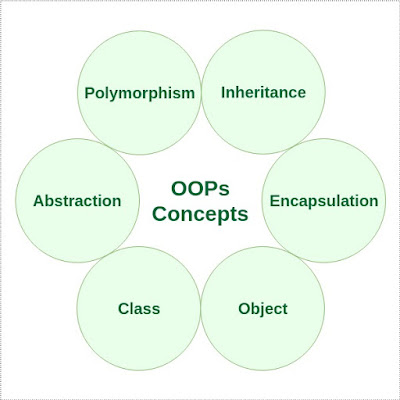Note Class 12 Chapter - 5 Object Oriented Programming
5.1 Concept of OOP
An approach that provides a way of modularizing programs by crating partitioned memory area for both data and functions that can be used as templates for creating copies of such modules on demand is called Object Oriented Programming.
5.2 Features of OOP
OOP posses following Characteristics / features:
a) Emphasis is given on data rather than procedures.
b) Data structures are designed such that they characterize the objects.
c) Functions that operate on the data of object are tied together in the data structure.
d) Data is hidden and cannot be accessed by external functions.
e) Objects may communicate with each other through functions.
f) New data and functions can be easily added whenever necessary.
g) Follows bottom-up approach in program design.
Advantages / importance of OOP
· Software complexity can be easily managed.
· Easy to upgrade from small to large systems.
· Data hiding helps to make more secure programs.
· Follows bottom: up approach in program design.
· It reduces the software maintenance cost.
Disadvantages of OOP
· Not all languages are suitable to implement the OOP concepts easily.
· Suitable only in long run while managing large software projects.
· It is not the action-oriented.
Object
The basic run-time entities in an object-oriented system are called object.
They may represent a person, a place, a bank account, a table of data or any item that the program has to handle. When a program executed, the objects interact by sending messages to one another for example, if “customer” and “account” are two objects in a program, then the customer object may send a message to the account object requesting for bank balance.
Each object contains data, and code to manipulate the data. Objects can interact without having to know details of each other’s data on code. It is sufficient to know the type of message accepted, and the type of response returned by the objects.
Object: STUDENT |
DATA: Name Date of birth Marks -------------- |
Functions: Total Average Display ------------ |
Class
A class is a collection of objects of similar type. For example, mango, apple and oranges are members of the class fruit. Once a class has been defined, we can create any number of objects belonging to that class with the data of type class with which they are created. The syntax used to create an object is no different than the syntax object in C. For example if fruit has been defined as a class, then the statement
fruit mango;
will create an object mango belonging to the class fruit.
Polymorphism
Polymorphism, a Greek term, means the ability to take more than one form. An operation may exhibit different instances. The behavior depends upon the types of data used in the operation. For examples: consider the operations of addition. For two numbers (2+3=5), the operation will generate a sum. If the operands are strings, then the operation would produce a third strings by concentration (“IBM”+ “PC”= “IBMPC”). The process of making an operator to exhibit different behaviors in different instances is called operator overloading.
Inheritance
Inheritance is the process by which objects of one class acquire the properties of objects of another class. In OOP, the concept of inheritance provides the idea of reusability. This means that we can add additional features to an existing class without modifying it. This is possible by deriving a new class from the existing one. The new class will have the combined features of both the classes. It supports the concept of hierarchical classification. For examples, the bird “robin” is a part of the class “flying bird” which is again a part of the class “bird”.
5.3 Application of OOP
The promising areas for application of OOP include:
· Real time systems.
· Simulation and modeling.
· Object – oriented database.
· Image processing and patterns recognition.
· Computer Aided Design system.
· AI and expert systems. Etc
5.4 Difference between OOP and structured programming language
Object – Oriented Programming | Structured – Oriented Programming (Procedure oriented Programming) |
1. It models real world problems very well. | 1. It does not model real world problems very well. |
2. Emphasis is on doing things (algorithms). | 2. Emphasis is on data rather than procedure. |
3. Programs are divided into objects. | 3. Programs are divided into function. |
4. Data is hidden and cannot be accessed by external functions. | 4. Data move openly from function to functions. |
5. Follows bottom-up approach in program design. | 5. Follows top-down approach in program design. |
6. Examples:- C++, Java, C# etc. | 6. Example:- C, Pascal, FORTRAN, Q-BASIC etc. |
Homework questions [Unit-5]
1. What is object – oriented programming? How it is different from the procedure oriented programming? (2068)
2. Write the advantages and disadvantages of OOP. (2069)
3. Why polymorphism and inheritance are important concepts of OOP? Explain. (2058, 2068)
4. What is procedural oriented programming? Explain. (2070)
5. What is OOP? Define the terms inheritance and polymorphism with examples. (2061, 62, 63, 64, 65, 67, 70 ‘D’)
Labels: Note Class 12 Chapter - 5 Object Oriented Programming

